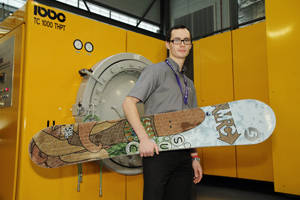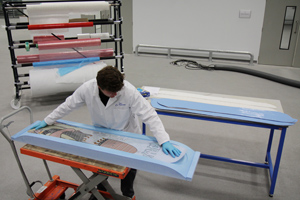 |
| January 15, 2013 | Volume 09 Issue 02 |
Designfax weekly eMagazine
Archives
Partners
Manufacturing Center
Product Spotlight
Modern Applications News
Metalworking Ideas For
Today's Job Shops
Tooling and Production
Strategies for large
metalworking plants
Biocomposites in prototype snowboard include flax and cashew nuts

Innovative biocomposite materials are heading for the slopes after engineers at the University of Sheffield's AMRC Composite Centre produced a prototype snowboard from flax, cashew nut husks, and recycled plastic. The team is investigating the potential use of these biocomposites for electric vehicles and other applications. The AMRC Centre in South Yorkshire, U.K., is a collaboration between the University of Sheffield and aerospace giant Boeing, with additional support from Rolls-Royce.
The aerospace and automotive sectors are increasingly using composite materials for their combination of low weight and high strength, which can provide significant improvements in fuel efficiency. These materials are usually made up of carbon or glass fibers embedded in an epoxy resin derived from petrochemicals. These materials are energy-intensive to manufacture and are not easily recyclable or biodegradable when they reach the end of their lives.
Replacing some or all of these raw materials with sustainable alternatives can significantly improve the environmental performance of composites manufacturing.
The AMRC Composite Centre investigated the use of fibers from flax and bamboo, as well as an epoxy resin derived from cashew nut husks that would normally go to waste, and produced two fairing panels for the AMRC's Mantra truck, a mobile showcase for advanced engineering on wheels, as showpieces.
Some of the young researchers at the AMRC Composite Centre then started looking at the potential for these materials in an area of special personal interest: snowboarding. The team launched an internal project that became known as SUSC: Snowboard Using Sustainable Composites.
"Snowboards need to be stiff, strong, and light, so are typically made from glass fiber or carbon fiber composite with a wooden core," says development engineer Craig Atkins. "We decided to take a look at replacing these with more sustainable materials. Flax is a relatively cheap bio-material with good mechanical properties, and a very good candidate for use in snowboards."

The team produced two boards from flax fibers embedded in a resin containing 30 percent of cashew shell epoxy. The core was made from recycled PET foam, derived from old plastic bottles and other waste.
One board is currently being put through its paces by one of the AMRC team, Alistair Murray, during a sabbatical in the Canadian mountains. The other is on show at the center, having drawn interest from businesses at the Composites Engineering Show at NEC in November as well as from the extreme sports community.
The AMRC team continues to develop biocomposites for a range of transport applications.
"There's a number of areas we need to investigate before these biocomposites can go into commercial production," says Dr Tim Swait, AMRC research engineer. "We will research how we can increase the concentration of fibers to give material properties that are at least a match for synthetic composites, and how we design the lay-up for a biocomposite component to optimize its performance. We're also investigating other techniques to improve the energy efficiency of composites manufacturing, such as microwave curing, and whether these can be applied to biomaterials."
Source: AMRC Composite Centre
Published January 2013
Rate this article
View our terms of use and privacy policy
